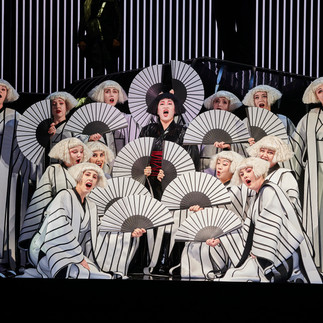Review: Madama Butterfly at Sydney Opera House
- Theatre Travels

- Jul 1, 2022
- 3 min read
Updated: Jul 7, 2022
Review by Olivia Ruggiero
Tumultuous is the word that comes to mind when reflecting on opening night of Puccini’s Madama Butterfly at Sydney Opera House. Bringing Butterfly into a digital dystopian world was never going to be an easy sell and this production by Graeme Murphy was certainly confronting and disconcerting. Originally premiering in 1904, this production is thrust into a dysfunctional world with allusions to steam punk, imperial Japan and 1960’s America, leaving the production feeling fragmented and without cohesion.
One must commend Diego Torre for attempting to sing through sickness. Torre is always exceptional – his warm tone, luscious upper register and resonance normally reverbs through the Joan Sutherland Theatre with ease and beauty. However, at interval I was left feeling disappointed – was Pinkerton just not Torre’s role? Perhaps something was array… and it certainly was. Mr Lyndon Terracini announced at the start of Act 2 that Diego Torre was ill and could no longer continue – this explained his struggle to reach his top notes – and that Young Artist, Thomas Strong was going to step into the role of Pinkerton for the second act. Strong was superb. His voice was glorious and blended beautifully with Michael Honeyman as Sharpless and Sae-Kyung Rim as Butterfly. His final cries at the end of the opera were filled with emotion, his voice dripping with despair. Strong certainly has a bright future and I, for one, am excited to see what he does next.
Sae-Kyung Rim is at home in the role of Butterfly. Her voice has the perfect amount of squillo to ping across every surface of the Joan Sutherland Theatre. Her rendition of “Un Bel Di” is a triumph; fraught with hope, desire, longing and heartbreak. Butterfly is a marathon and at the end Rim has given it everything she had. One of the most difficult roles to tackle and she does it with grace. Brava.
Sian Sharp is fire on stage. She tackles the role of Suzuki with gusto. Her voice is nothing short of flawless, her acting far superior to anyone with whom she shared the stage, and her presence is electric. If she was on stage – I was watching her. Sharp sinks her teeth into this role offering everything she has to give as a performer. Her physicality is excellent. “Tutti I fior?” more commonly known as “The Flower Duet” was the stand-out moment in this opera. Sharp and Rim’s voices blending perfectly heightening Puccini’s melodic bliss.
There is no denying there are some visually stunning moments - Butterfly entangled in blood red rope symbolising how her enamoured state leaves her trapped resulting in her committing the ultimate sacrifice; or the colourful painting of the garden, digitally, in Tutti I fior? But I was often left questioning why certain visual elements were in place. What was the purpose of the contemporary dancers, clad in white with tree branches in Act 2? Why was there a digital re-enactment by contemporary dancers of the love scene on a scrim in front of the superb vocalists who were still acting and pulling focus? There’s a lot going on in this production, a lot of ideas, visual spectacles, and confrontational imagery, all of which have a place in opera but perhaps not executed in this way. Bringing opera into the modern world, for a young and modern audience is vital, and can leave a true impact. At the end of Madama Butterfly I am left contemplating what its purpose was in this particular production and how it reflects upon our modern world.
Image Credit: Guy Davies






































